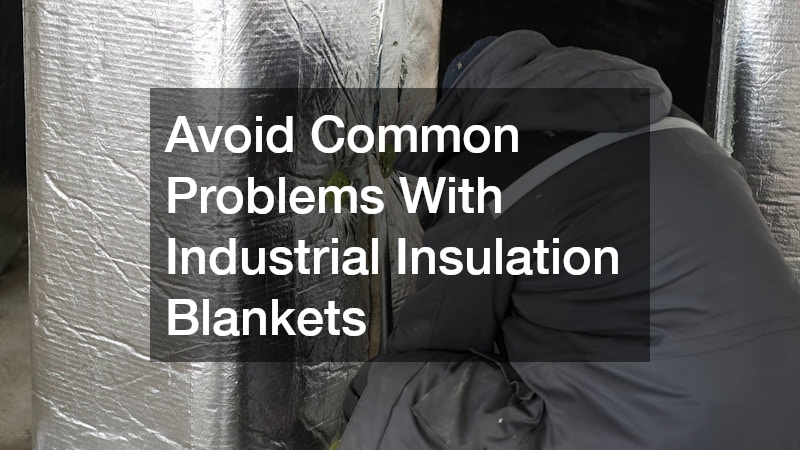Industrial insulation blankets are essential for maintaining optimal thermal efficiency and safety in various settings. However, these blankets can present several common issues that, if not addressed, can compromise their effectiveness. This article explores the most frequently asked questions about thermal insulation covers and provides insights into avoiding common pitfalls.
Why Do Thermal Insulation Covers Underperform?
Poor Material Selection
Selecting the right material for industrial applications is crucial to ensure thermal insulation covers perform effectively. Inadequate material choice can lead to insufficient thermal resistance, thereby reducing the blanket’s ability to maintain optimal temperatures. Additionally, selecting materials that are not compatible with specific environmental conditions can lead to accelerated wear and tear.
For instance, environments with high humidity could cause certain materials to deteriorate faster, leading to a compromise in insulation performance. Engineers must acquaint themselves with the chemical and physical properties of potential materials before making a choice. Understanding the importance of selecting the right material ensures the longevity and reliability of thermal insulation covers.
Failure to choose proper materials often results in unnecessary loss of energy and increased operational costs. Improperly selected materials may not only underperform but could also pose safety hazards. Therefore, making informed material selections can mitigate the risk of underperformance of thermal insulation covers.
Improper Installation Techniques
Installation plays a significant role in the effectiveness of thermal insulation blankets. Common installation mistakes, such as misaligned seams or improperly sealed joints, can lead to energy loss and reduced efficacy. Ensuring precise and correct installation is, hence, essential for achieving maximum performance.
Technicians often overlook specific installation guidelines, which can cause inadequate thermal coverage. This oversight can result in uneven distribution of insulation, leading to potential hot spots. Regularly training installation teams on best practices helps in overcoming these challenges and ensures the optimal functioning of thermal insulation covers.
Improper installation techniques not only affect functionality but also reduce the lifespan of the insulation covers. Missteps during installation could necessitate frequent maintenance and replacements. By avoiding these common installation pitfalls, industries can significantly improve the performance of their thermal insulation covers.
What Are the Key Benefits of Using Thermal Insulation Covers?
Energy Efficiency Improvement
Thermal insulation covers play a pivotal role in improving energy efficiency. By reducing heat loss, these covers contribute significantly to lowering energy consumption and operational costs. Industries that invest in high-quality insulation solutions can expect substantial energy savings over time.
The increased energy efficiency can also lead to enhanced productivity as equipment maintains optimal operating temperatures. Furthermore, reduced energy usage directly correlates with a decrease in fuel consumption, contributing to cost savings. These covers are, hence, a valuable asset in enhancing overall energy management strategies.
By maintaining stable temperatures, thermal insulation covers help industries adhere to regulatory compliance and environmental standards. They minimize the carbon footprint by reducing emissions associated with energy production. This contributes positively to sustainability goals, making them indispensable in modern industrial settings.
Safety Enhancements
Thermal insulation covers are instrumental in enhancing safety within industrial environments. They protect employees and equipment from heat-related hazards, reducing the risk of burns and associated accidents. Effective insulation also minimizes equipment stress, contributing to increased operational reliability.
In high-temperature environments, insulation covers serve as barriers that shield sensitive components from extreme heat. This protection helps prevent malfunctions and prolongs the lifespan of machinery. Additionally, heightened safety measures foster a culture of workplace security, promoting employee confidence and morale.
Investing in reliable thermal insulation solutions can lead to fewer occupational injuries and related disruptions. Ensuring the safety of both personnel and assets enhances productivity and reduces the liability risks for organizations. These safety measures highlight the indispensability of thermal insulation covers in industrial operations.
How to Choose the Right Thermal Insulation Covers?
Consideration of Temperature Ranges
Selecting thermal insulation covers requires careful consideration of specific temperature ranges. Different applications may subject covers to varying temperature challenges; hence, the selection process must account for this variability. Understanding operational temperature limits is critical in ensuring insulation performs optimally.
Industry professionals should consider the thermal resistance capability required for their specific applications. Using covers that are ill-suited for a particular temperature range can lead to ineffective insulation and potential material degradation. Evaluating the temperature demands of equipment and environments is a prerequisite for making informed selection decisions.
Proper consideration of temperature ranges leads to the appropriate choice of material and design. This ensures the energy efficiency and safety benefits of thermal insulation covers are fully realized. By aligning cover specifications with operational requirements, industries can enhance both performance and durability.
Assessing Durability and Material Quality
Durability and material quality are paramount factors to consider when choosing thermal insulation covers. High-quality materials provide robust resistance to wear and environmental conditions, extending the longevity of the insulation. Durability assessments enable industries to invest in covers that withstand the rigors of industrial environments.
Evaluating material quality includes examining tensile strength, thermal performance, and resistance to chemicals or UV exposure. Material testing ensures that chosen covers have the resilience to perform under specific operational demands. By prioritizing durability, industries can avoid frequent replacements, thus optimizing investment in thermal insulation covers.
Ensuring high standards of material quality not only supports effective thermal management but also contributes to safety and cost-efficiency. Quality assessments provide insights into the expected lifecycle and maintenance needs of covers. Choosing durable materials is a fundamental step in enhancing the overall utility and reliability of insulation solutions.
Avoiding common problems with industrial insulation blankets requires careful consideration of material selection, installation, and maintenance. By understanding their role in energy efficiency, safety, and environmental impact, industries can make informed decisions when selecting and maintaining thermal insulation covers, ensuring their long-term effectiveness and sustainability.



